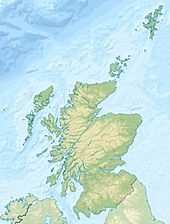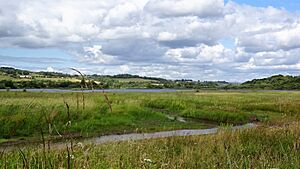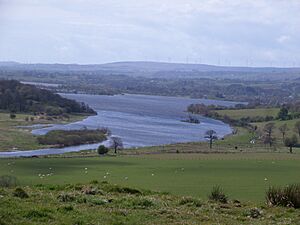The Peel of Castle Semple facts for kids
Quick facts for kids The Peel of Castle Semple |
|
|---|---|
| Castle Semple Loch, Renfrewshire, Scotland |
|
| Coordinates | 55°52′51″N 4°39′51″W / 55.880943°N 4.6640600°W |
| Site information | |
| Owner | Private |
| Open to the public |
No |
| Condition | A ruin |
| Site history | |
| Built | 17th century |
| Built by | Semple family |
| In use | 17th century |
| Materials | Stone |
The ruins of The Peel of Castle Semple are also known as the Castle Semple Loch Peel Tower. This old castle stands on a small, rocky island in Castle Semple Loch. The loch is located in Lochwinnoch Parish, Renfrewshire, Scotland. Long ago, during the Scottish Reformation, it was called the Defender of the Faith. Over time, the island became connected to the shore. This happened because of drainage work and farming nearby. The Semple family built this castle. Sometimes, 'Semple' is spelled 'Sempill', but we will use 'Semple' here.
Contents
History
Robert, 3rd Lord Semple
In August 1560, the Scottish parliament officially accepted the 'Confession of Faith'. This was a big step in the Scottish Reformation. However, Robert Semple, 3rd Lord Semple remained a strong Catholic. He continued to practice his faith and disagreed with the Reformation.
Lord Semple was a loyal supporter of Mary, Queen of Scots. He also supported the queen regent, Mary of Guise. They were against the followers of John Knox. John Knox himself described Lord Semple as someone who strongly opposed his beliefs.
In July 1560, a peace treaty was signed. But Lord Semple and others continued to cause trouble. They carried out many violent acts. They stole animals and burned down buildings and crops.
Lord Semple was asked to explain his actions to the Justice-General. Instead, he decided to make Castle Semple stronger. He also built a new fortified house on an island. This new building was a peel tower. It was built on a rocky island in the loch. This is the ruined castle you see today. It is now connected to the shore by an earthen path.
The Peel of Castle Semple was built for safety. It was a strong place to hide during dangerous times. But when things were peaceful, the Semple family also used it for fun. Carved stones found there show it was a comfortable place. It was built just before 1560. This was a time of great trouble during the Scottish Reformation. It was meant to be a safe and unbeatable retreat.
Lord Semple named his new fort "Defender of the Faith." This name shows why he built it. He was against the Protestant faith that was spreading.
The Castle Semple siege
The Earl of Glencairn gathered soldiers and cannons to attack Castle Semple. Lord Sempill went to Dunbar Castle for safety. His son, the Master of Semple, and his brother stayed to defend Castle Semple. On September 18, Glencairn's soldiers approached the castle. Sempill's men shot at them from the windows.
The young Earl of Arran joined the attackers. The English ambassador, Thomas Randolph, was also there. They camped in a barn.
After seven days of bad weather, the attackers set up their cannons. By the next afternoon, the Castle Semple gatehouse was destroyed. Glencairn's soldiers tried to enter through the broken walls. But they were pushed back. The next morning, October 19, 1560, a white flag appeared. The siege was over. William Kirkcaldy of Grange and the Laird of Stenhouse arranged the surrender.
A Captain Forbes and ten men were left to guard Castle Semple and the peel. The rest of the soldiers left. Some were happy to be alive, and others were happy with their pay. The lords went to Hamilton.
Lord Semple's son, the 'Master of Semple', was captured. He was taken to Hamilton. His father was not at the castle during the siege. In 1561, Lord Semple made peace with the authorities. Meanwhile, the Protestant Reformation continued. Important figures like the Earls of Argyle and Glencairn burned down abbeys. These included Paisley Abbey and Kilwinning Abbey.
After Henry Stuart, Lord Darnley was killed in 1567, Lord Semple changed sides. He played a big part in Mary Queen of Scots' downfall. He also helped with her imprisonment.
Lord Semple was a bailie (a local official) for Archbishop John Hamilton. Archbishop Hamilton was a Catholic. He was found guilty of being involved in the murders of Regent Moray and Lord Darnley in 1571.
The bronze cannons
In the 1700s and 1800s, several bronze cannons were found in the loch. They were near the peel tower. Each cannon had a falcon symbol and the letters 'IRS'. This stood for James V of Scotland. These cannons were probably used during the siege. One was kept at Castle Semple House. It is now in the Glasgow Museums at the Kelvingrove Museum. These cannons might have been lost during transport. Or they might have been put there on purpose. This would have stopped the peel tower from being used again right away.
Castle Semple Loch
Castle Semple Loch was once very large. It was about 4.5 miles long and nearly a mile wide. But between 1680 and 1774, a lot of drainage work was done. This made about 400 acres of rich land available. This land, like Aird's Meadow, was used for farming and grazing. Because of this, the loch became smaller and shallower. Some of this work had to be undone later. This was to provide water for mills powered by the Black Cart Water.
On William Roy's map from around 1747–1755, the peel is shown on a piece of land. This land extended from the shore near Lochside House. By 1800, the water level had risen again. The peel was then shown on an island.
In 1856, an embankment was built around Aird Meadow. This area was being farmed, but it would flood in winter. The peel tower was located on this embankment.
Description
Peel Towers or tower houses were small fortified buildings. They were often built as watch towers in high places. From these towers, people could send signals, like fires, to warn of danger. The Castle Semple Loch tower had gun ports, showing it had cannons. It probably stood at least three stories high. The ruins we see today might have been built around 1560. This was when Robert Semple, 3rd Lord Semple was fighting against the Scottish Reformation.
The tower had fancy carved stones. Its overall shape was an irregular pentagon. One sharp end pointed towards the head of the loch.
The ruins have gun ports on the ground floor. There was also a circular spiral stair. This stair once led to the living areas on the floor above. The ground floor cellar had a curved, vaulted ceiling. In an 1856 survey, it was hard to understand the building's layout. This was because of all the rubble and stones.
In 1826, the peel was shown as complete. It sat on a small island. A causeway connected it to the shore at Lochside House.
After 1856, most of the rubble was cleared away. This revealed much of the lower part of the peel tower. The tower walls are still about 3 meters thick. The corners are made from cut stone. The walls on the northwest and southeast sides are still about 3 meters high. The wall to the southwest also stands. But on the northeast side, only the foundations remain. This is probably because stones were taken from there. They might have been used to build the embankment around Aird Meadow. The walls have a core of rubble. The outside is faced with square-cut stones. In the east corner, you can still see parts of a newel or spiral stair. This stair led to the upper floor.
Aird Meadow
As mentioned, the peel tower was built on an island in the loch. Old maps show this. But a lot of drainage work reduced the loch's size and depth. The creation of Airds Meadow involved building an embankment. This embankment connects the island to the shore near Lochside House.
In the Scottish language, 'Aird' means a piece of dry ground. It is different from a body of water. An example is Airds Moss.




